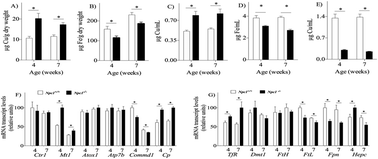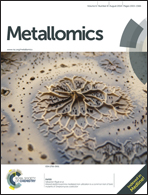Hepatic metabolic response to restricted copper intake in a Niemann–Pick C murine model†
Abstract
Niemann–Pick C disease (NPC) is a vesicular trafficking disorder primarily caused by mutations in the Npc1 gene and characterized by liver dysfunction and neuropathology. Altered hepatic copper metabolism has recently been reported in NPC disease. Therefore, we aimed to analyze the effects of a copper deficient diet and copper chelation using D-penicillamine on copper homeostasis in the liver of Npc1−/− mice of different ages. We examined liver metal ion content by AAS, and copper and iron metabolism gene expression in the liver using qPCR in Npc1+/+ and Npc1−/− mice. We found higher copper and lower iron content in the liver of Npc1−/− mice of different ages, compared to controls; these changes in copper and iron content were correlated with increased ceruloplasmin, metallothionein 1, and transferrin receptor gene expression and decreased gene expression of Commd1, ferritin-light chain and ferroportin in the liver of Npc1−/− mice of different ages. Npc1−/− mice responded to a copper-deficient diet with a decrease in copper content in the liver, bile and heart. These results correlated with a reduction in the hepatic expression of ceruloplasmin and metallothionein 1 during the first week of treatment. D-penicillamine revealed hepatic adaptive response and an improvement in hepatic function in Npc1−/− mice without any effect on neurological functions. Our results confirm that the NPC1 protein is required for copper and iron homeostasis. To our knowledge, this is the first report documenting the hepatic adaptive response to low-copper intake in a Npc1−/− mouse model.


 Please wait while we load your content...
Please wait while we load your content...